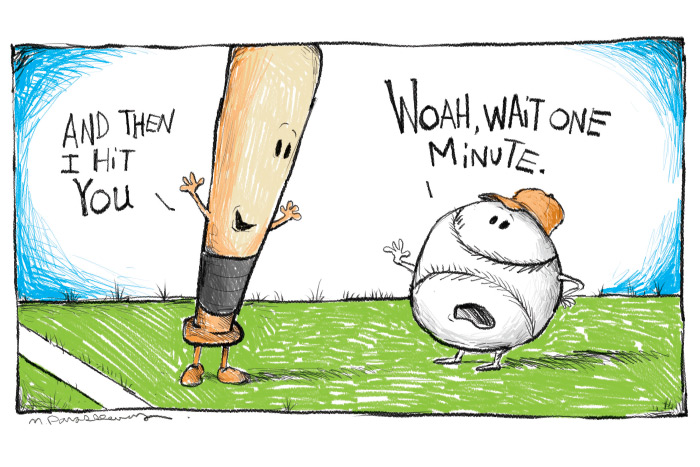How to Explain Baseball to the Uninitiated

Ever try to explain baseball? The other day I got sort of trapped into it.
A friend was visiting us from England, and when I came down to breakfast he said I looked tired. I told him I had been up until two in the morning watching the first game of the World Series. The Mets were two outs away from winning in the ninth, but a Kansas City player hit a home run against Familia, the Mets’ great closer, which sent the game into extra innings. It didn’t end until the 14th.
He blinked.
Don’t you know baseball? I asked. And so it began.
I tried starting by explaining that hit in the ninth, but quickly realized that would not work. So I started at the beginning.
There are two teams, I said. There’s a ball and a bat and for a while a member of one team using a bat tries to hit the ball over a fence far away after a player on the other team throws it at him, but it has to be nearby so the batter gets a good chance to hit it. The thrower, which we call a pitcher, is just one particular very big and strong individual who is very good at that. If the batter hits it over the fence, or in another place where nobody can get to it quickly near the fence, then that is good. After he hits it or doesn’t, then the hitting team brings in a new batter, and so eventually all the players on the hitting team, nine of them, one after the other, get to try to hit it over the fence. If all nine do that, or come near to it by hitting it in a good place, then they start around again against the pitcher.
However, in the course of things, if the batters try to hit it over the fence one after the other and after a while three of them cannot do it, or if they do other bad things like swing and miss three times, then the penalty is they change sides. So then the batting team goes out by the fence and the big pitcher for the batting team now throws to the old pitching team, who are now the batters.
He blinked.
One full time where both sides get to hit and finally fail three times is called an “inning,” I told him. They play nine innings, and at the end of that time the team that has hit the ball over the fence the most times is declared the winner.
Well, that sounds pretty straightforward, my friend said.
Well, there are nuances, I said. For instance, with nine players on a side, when the pitcher is pitching, his eight teammates stand around him, some near and some far by the fence, and try to catch the ball when it is hit. If one does catch it, then that is as good as when the batter misses hitting the ball three times. Either way it is an “out.” And the batter is “retired” and there is a new batter. Then after three batters don’t do good, as I said, they change sides.
I get it, he said.
It can be quite dramatic. When one of those standing around in the field leaps up and catches the ball, which might otherwise have gone over the fence, thereby making an “out,” everybody stands up and cheers.
And if the batter hits it over the fence?
The fans rooting for the other team stand up and cheer.
Jolly good.
I then explained about what happens if a batter hits it short of the fence, but in a place where the opposing players can’t catch it.
“That’s what I meant when I said it’s hit in a good place,” I said.
There are three small, soft white bags in various places on the ground that are safe places for the batter to run to if he is able to hit the ball where nobody can get at it right away.
“If he can get to one of these bags and keep one foot on it, then it is a good thing,” I said.
“He runs to them?”
“Yup, he runs as fast as he can to get to one. That’s because a fielder can pick up the ball where it rolls to and throw it to another fielder guarding the base and that fielder, if he has the ball, can tag the runner before he gets there, and that’s the same thing as striking out or flying out.”
An hour later, moving slowly like this and occasionally introducing new concepts, such as a pick-off, a walk, a stolen base, a foul ball, a triple, a double play, players on base scoring and so on, I got to a point where I felt it safe to try to explain the ninth inning.
“As you can imagine,” I said, “a pitcher throwing the ball like that, sometimes a hundred miles an hour, can get tired. So, pitchers who start the game are usually only are able to play really well through about seven innings. At that point, they have to be replaced.”
“Is there a penalty for that?”
“No. Except when a pitcher is removed, he can’t come back in. He’s done for the day. So who they bring in to pitch is another big strong man, but this time one whose job it is to just pitch the last inning, or last two innings. Both teams have them. They are called “closers” because they are trying to “close” the game out. All they have to do is get six men out, three in each of the last two innings. Either one team is ahead or the other. Or they are tied.”
“With runs,” he said.
“Yes. So now it is the last half of the ninth inning, Kansas City’s last chance at bat and they are behind by one run, 4 to 3. New York has a really good closer named Jeurys Familia. Tall, strong, calm, square jaw, from the Dominican Republic, I think. His job is to save the win.
“He strikes out the first batter, so now there are just two more outs to go, and the New York Mets win. I am rooting for the Mets and I and everybody else are very excited. But then the second batter swings and hits it over the fence.”
“Oh lordy,” my friend says. “It’s tied.”
“This is a very rare thing. Closers are so good. Familia gets the next two outs to end the inning, and then he strides off the field to the dugout and he is really angry at himself. He throws down his mitt. His close has now been transformed into a “blown save.”
“Well named. So what happens?”
“They go into extra innings. The Mets are the guests, so they continue on as first up for the new inning. If they score, the Kansas City team gets to bat in the bottom half. If they can’t score in the bottom half of the inning, it’s over and the Mets win. If they can duplicate what the Mets did, it continues on. But if they can score one more than the Mets did, they win. It’s over.”
“And how long can this go on?”
“Well, the nine innings generally takes two and a half hours. It’s a leisurely game. But now the extra innings can continue, in theory, forever. Sometimes they play 20 or 25 innings. It just keeps on going.”
“And?”
“In the bottom of the 14th, Kansas City scored. And that was that. This game took five hours and nine minutes.”
“Is there another game, or was that it?” he asked.









